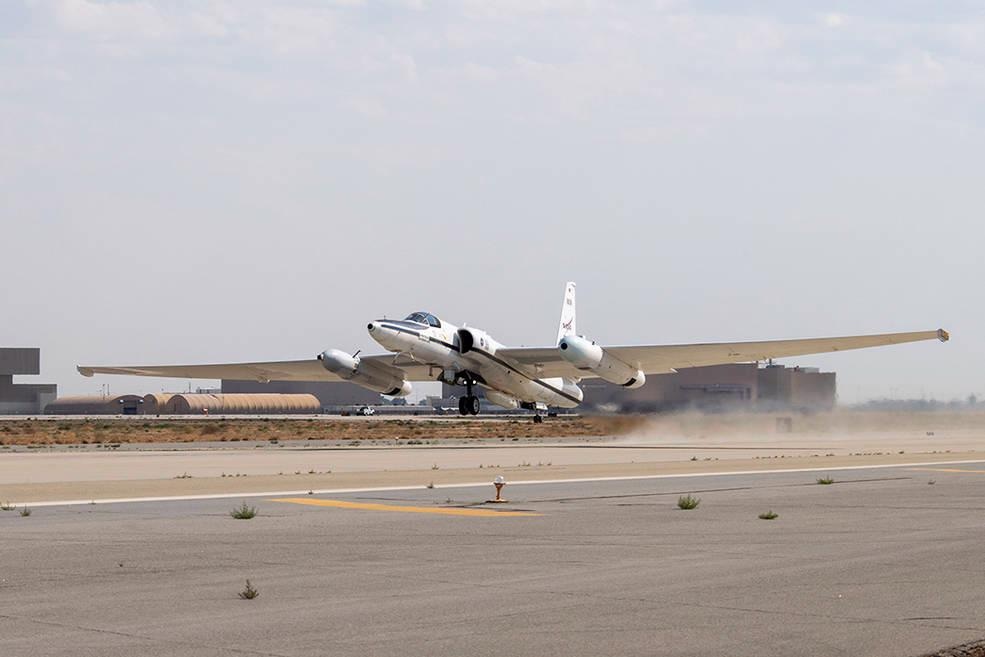NASA's ER-2 aircraft will soar to altitudes as great 70,000 feet above Kansas to collect samples of particles deposited in the stratosphere by overshooting storms.

NASA’s Armstrong Flight Research Center ER-2 #809 high-altitude aircraft taking off for Dynamics and Chemistry of the Summer Stratosphere (DCOTSS) science flights in Palmdale, CA on June 17, 2021. Image Credit: NASA Photo / Carla Thomas
A NASA airborne science campaign studies the effect that intense summer storms, over the central United States, have on the atmosphere. The sub-orbital project is expected to assist researchers in better understanding how particles deposited in the stratosphere by such storms affect the planet's atmosphere and how they relate to climate change.
The project entitled the Dynamics and Chemistry of the Summer Stratosphere (DCOTSS)¹ is operated as part of NASA's Earth Science Division and uses ER-2 aircraft — previously based at the agency's Armstrong Flight Research Center, Edwards, California.
Flying out of Salina, Kansas, the aircraft began its mission on July 16th, climbing to an altitude of around 70,000 feet to collect chemical samples of the Earth's atmosphere. The science flights will continue throughout and well into 2022.
The samples collected by ER-2 will help scientists examine material that is lifted into the stratosphere high above the lower layers of the atmosphere by convective or overshooting storms. This, in turn, should reveal how chemical processes and dynamics shape the composition of the stratosphere. The research could also show how this composition adapts in response to climate change.
Approximately 50,000 storms occur over the U.S. during a typical summer, so almost every day, somewhere in the U.S., overshooting storms are happening. There are many scientific questions about the effects of these storms on the stratosphere that we will be able to address with data from DCOTSS.
Kenneth Bowman, Principal Investigator, DCOTSS
As overshooting storms can deposit water vapor — a key greenhouse gas — into the stratosphere, the mission also could grant important insight into how such weather events play a role in climate change.
Going Stratospheric with Overshooting Storms
Most material lifted into the atmosphere doesn't reach the stratosphere, so collecting samples doesn't usually require such high-altitude missions.
Overshooting storms with their convective cloud tops — defined by the American Meteorological Society as a domelike protrusion above a cumulonimbus anvil, representing the intrusion of an updraft through its equilibrium level² — can transport material from the troposphere up to the stratosphere. Once this material reaches these altitudes, it can become trapped there by atmospheric circulation.
That means sampling and studying this material requires a method of collection that can match these high altitudes. That's what makes ER-2 — an aircraft that can achieve higher altitude flight than any other sample collection platforms — perfect for this study.
As the aircraft has been fitted with 12 instruments capable of measuring gases and particles carried into the stratosphere by intense thunderstorms, it is the first mission specifically designed to study the effect of overshooting storms.
Bowman, also a professor of atmospheric science at Texas A&M University, says that the team will be specifically looking to discover what processes are occurring at the top of these storms as well as the effects that man-made chemicals are having on the stratospheric ozone layer.
The team will also attempt to determine the composition of aerosol particles at this altitude and trace them back to where they originate.
Underestimating Overshooting Storms
Part of the reason this research is coming about now is that researchers didn't know just how common overshooting storms are until recently. During the last ten years, the study of thunderstorms with data collected by radars and satellites has shown just how frequently these intense storms occur over the U.S. The area most commonly affected by overshooting storms is the central U.S., making Kansas is the ideal base of operations for ER-2's mission.
The craft will collect samples from the proximity of around 50 km downwind of these storms — close enough to collect accurate data, but still distant enough to maintain safety.
The ongoing operation will commence with a five-week test flight period to check that the aircraft's instruments are properly calibrated and to collect data from areas not affected by storms. This test run began in June with the craft flying out from California. Beyond a check of instrumentation and collection methods, these initial samples will form an important baseline to check storm-influenced samples against.
This trial period will be followed by at least two seven-week science missions, which will collect samples from over the midwest containing particles that have been deposited in the atmosphere by overshooting storms.
Disclaimer: The views expressed here are those of the author expressed in their private capacity and do not necessarily represent the views of AZoM.com Limited T/A AZoNetwork the owner and operator of this website. This disclaimer forms part of the Terms and conditions of use of this website.
Sources:
1. Dynamics and Chemistry of the Summer Stratosphere (DCOTSS), [https://www.dcotss.org/]
2. Bedka. K., Brunner. J., Feltz. W., Dworak. R., [2011], 'Overshooting Top and Enhanced-V Detections,' NOAA, [https://www.goes-r.gov/products/ATBDs/option2/Aviation_OvershootingTop_v1_no_color.pdf]